Archer C80 V2 User Guide
- About This Guide
- Chapter 1 Get to Know About Your Router
- Chapter 2 Connect the Hardware
- Chapter 3 Log In to Your Router
- Chapter 4 Set Up Internet Connection
- Chapter 5 TP-Link Cloud Service
- Chapter 6 Guest Network
- Chapter 7 Parental Controls
- Chapter 8 QoS
- Chapter 9 Network Security
- Chapter 10 NAT Forwarding
- Chapter 11 Customize Your Network Settings
- Chapter 12 Manage the Router
- FAQ
- Authentication
Chapter 4 Set Up Internet Connection
This chapter introduces how to connect your router to the internet. The router is equipped with a web-based Quick Setup wizard. It has necessary ISP information built in, automates many of the steps and verifies that those steps have been successfully completed. Furthermore, you can also set up an IPv6 connection if your ISP provides IPv6 service.
It contains the following sections:
•Quick Setup Via TP-Link Tether App
•Manually Set Up Your Internet Connection
The Quick Setup Wizard will guide you to set up your router.
Tips:
If you need the IPv6 internet connection, please refer to the section of Set Up an IPv6 Internet Connection.
Follow the steps below to set up your router.
1.Visit http://tplinkwifi.net, and log in with the password you set for the router.
2.Follow the step-by-step instructions to complete Quick Setup configuration or go to Advanced > Quick Setup for configuration to connect your router to the internet. Then follow the step-by-step instructions to connect your router to the internet.
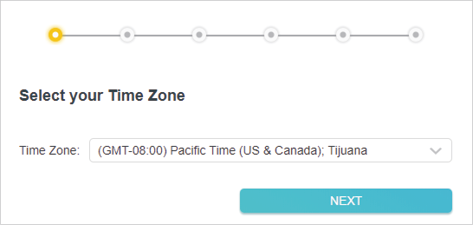
3.To enjoy a more complete service from TP-Link (remote management, TP-Link DDNS, and more.), log in with your TP-Link ID or click Sign Up Now to get one. Then follow the instructions to bind the cloud router to your TP-Link ID.
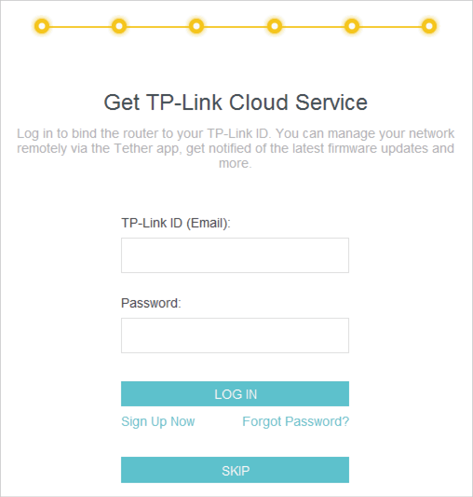
Note:
•To learn more about the TP-Link Cloud service, please refer to the TP-Link Cloud Service section.
•If you do not want to register a TP-Link ID now, you may click Skip to proceed.
•If you have changed the preset wireless network name (SSID) and wireless password during the Quick Setup process, all your wireless devices must use the new SSID and password to connect to the router.
2. Quick Setup Via TP-Link Tether App
The Tether app runs on iOS and Android devices, such as smartphones and tablets.
1.Launch the Apple App Store or Google Play store and search “TP-Link Tether” or simply scan the QR code to download and install the app.

2.Connect your device to the router’s wireless network.
3.Launch the Tether app, tap the + button and select Router > Wireless Router. Follow the steps to complete the setup and connect to the internet.
4.Connect your devices to the newly configured wireless networks of the router and enjoy the internet!
3. Manually Set Up Your Internet Connection
In this part, you can check your current internet connection settings. You can also modify the settings according to the service information provided by your ISP.
Follow the steps below to check or modify your internet connection settings.
1.Visit http://tplinkwifi.net, and log in with your TP-Link ID or the password you set for the router.
2.Go to Internet.
3.Select your internet connection type from the drop-down list.

4.Follow the instructions on the page to continue the configuration. Parameters on the figures are just used for demonstration.
1 )If you choose Dynamic IP, you need to select whether to clone the MAC address. Dynamic IP users are usually equipped with a cable TV or fiber cable.
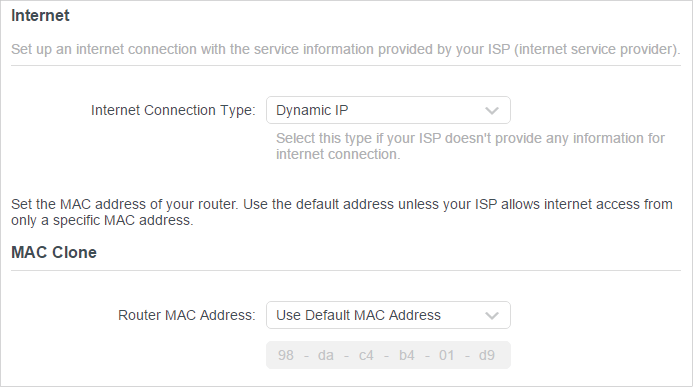
2 )If you choose Static IP, enter the information provided by your ISP in the corresponding fields.
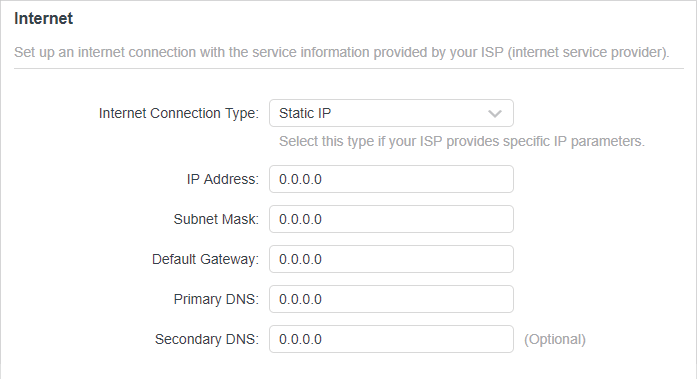
3 )If you choose PPPoE, enter the username and password provided by your ISP. PPPoE users usually have DSL cable modems.
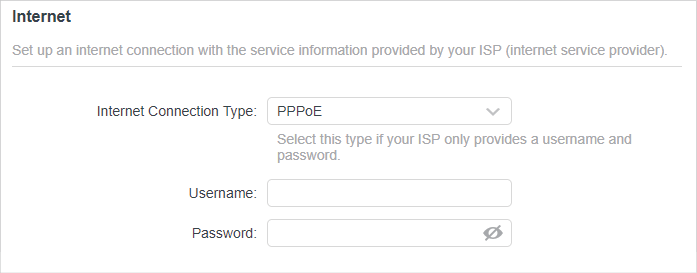
4 )If you choose L2TP, enter the username and password and choose the Secondary Connection provided by your ISP. Different parameters are needed according to the Secondary Connection you have chosen.
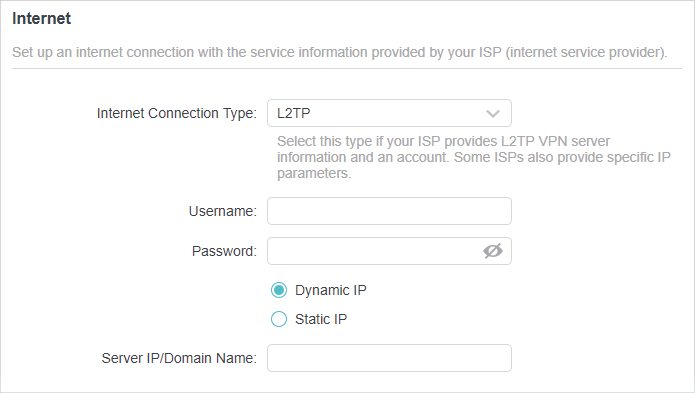
5 )If you choose PPTP, enter the username and password, and choose the Secondary Connection provided by your ISP. Different parameters are needed according to the Secondary Connection you have chosen.
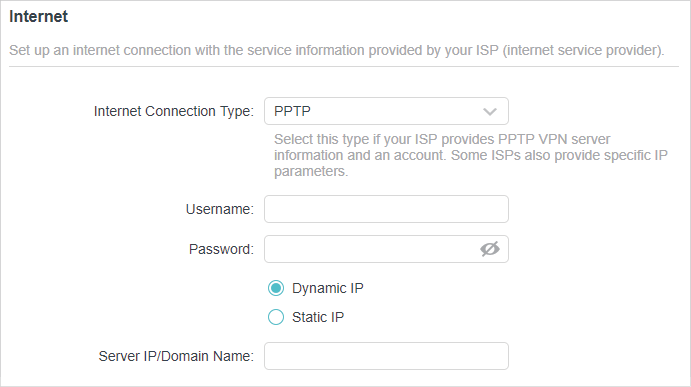
5.Click Save.
Tips:
•If you use Dynamic IP and PPPoE and you are provided with any other parameters that are not required on the page, please go to Advanced > Network > Internet to complete the configuration.
•If you still cannot access the internet, refer to the FAQ section for further instructions.
4. Set Up the Router as an Access Point
The router can work as an access point, transforming your existing wired network to a wireless one.
1.Visit http://tplinkwifi.net, and log in with your TP-Link ID or the password you set for the router.
2.Go to Advanced > Operation Mode, select Access Point and click Save. The router will reboot and switch to Access Point mode.
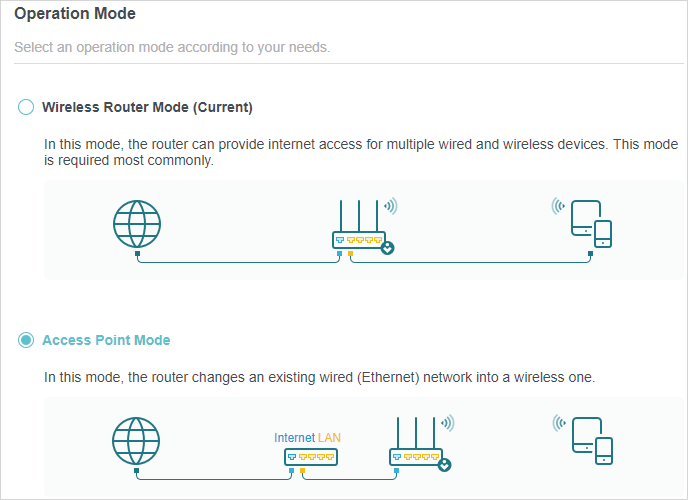
3.After rebooting, connect the router to your existing wired router via an Ethernet cable.
4.Log in again to the web management page http://tplinkwifi.net, and go to Advanced > Quick Setup.
5.Configure your wireless settings and click Next.
6.Confirm the information and click Save. Now, you can enjoy Wi-Fi.
Tips:
•Functions, such as Parental Controls, QoS and NAT Forwarding, are not supported in the Access Point mode.
•Functions, such as Guest Network, are the same as those in the Router mode.
5. Set Up an IPv6 Internet Connection
Set up an IPv6 connection if your ISP provides IPv6 service.
1.Visit http://tplinkwifi.net, and log in with your TP-Link ID or the password you set for the router.
2.Go to Advanced > IPv6.

3.Select the mode provided by your ISP to enable IPv6 connection.
Tips:
If you do not know what your internet connection mode is, contact your ISP or judge according to the already known information provided by your ISP.
•Pass-Through (Bridge):
1 )Select Pass-Through (Bridge) and click Save.
2 )Go to Network > Status to check whether you have successfully set up an IPv6 connection.

•Router:
1 )Select Router mode.
2 )Configure the WAN connection.
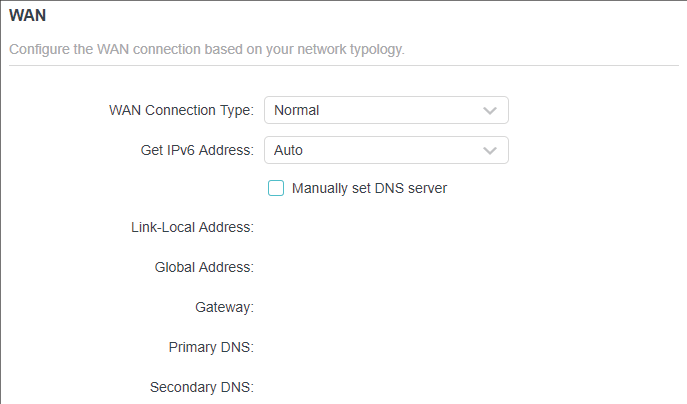
Notes:
1.If you do not know what your internet connection mode is, contact your ISP or judge according to the already known information provided by your ISP.
2.If your ISP provides two separate accounts for the IPv4 and IPv6 connections, manually enter the username and password for the IPv6 connection.
3 )Keep the default settings of LAN.

4 )Click Connect then click Save to apply your settings.
5 )Go to Network > Status to check whether you have successfully set up an IPv6 connection.
Tips:
Visit the FAQ section if there is no internet connection.